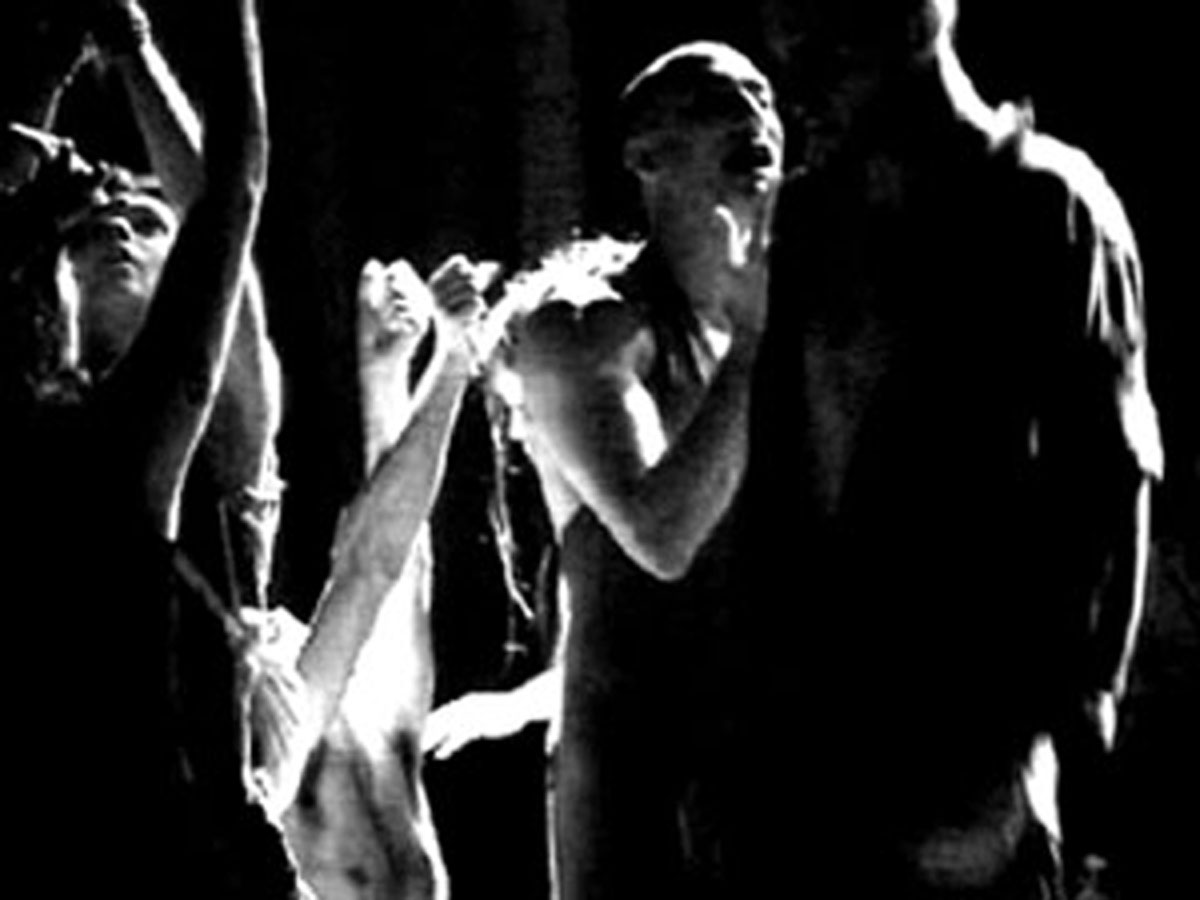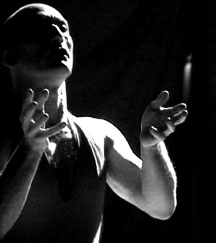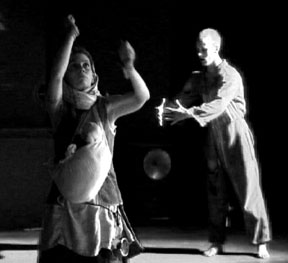BARE BONES RITUAL
Interview with Antero Alli, founder of ParaTheatrical ReSearch
by MYRDDIN MASERY, November 2009
Paratheatre is a type of sacred theatre. The goal "is to discover individual movements, actions and group rituals for triggering miraculous interactions. They are miraculous whenever they invoke (by sound & word) or evoke (by feeling & motion) strong spiritual and visceral resonances that — with enough commitment — erupt in spontaneous gestures, movements, patterns of motion, sounds, vocal creations, characterizations, and stories to be shared with others." In September 2009, I interviewed Antero Alli, the founder of ParaTheatrical ReSearch in Berkley, California. - M.M.
MYRDDIN MASERY: When and how did you discover the theories and works of Jerzy Grotowski?
ANTERO ALLI: I discovered the theories and works of Jerzy Grotowski in 1977. At that time, I was working in a group paratheatrical experiment in Berkeley California directed by David Rosenbloom. This group attended the Pacific Film Archive screening of Grotowski's film document of his Polish Laboratory Theatre's performance of "AKROPOLIS". Soon thereafter, I also read his book "TOWARDS A POOR THEATRE" and started applying its exercises and ideas into action within the group dynamics already in momentum.
Over the next thirty-two years, I have been busy incorporating additional techniques and ritual forms into what has become a new medium of paratheatre, a kind of group ritual technology for Self-initiation that is Grotowski-inspired, rather than Grotowski-defined. This paratheatre medium is not copying or aspiring to replicate Grotowski's work but has taken off towards other levels of accessing, expressing and embodying the internal landscape. This group work has been documented in my book, "Towards an Archeology of the Soul" and in three video documents.
MYRDDIN MASERY: What are the challenges of controlling urban and wilderness spaces?
ANTERO ALLI: Most of our ritual work occurs indoors in dance and yoga studios. Controlling these ritual workspaces amount to securing three hours that are completely free of external interruptions like people walking in or phones ringing. Beyond that, each individual is in charge of their own personal ritual processes and the personal space they use to engage their internal dynamics. Our approach to group ritual is also very bare bones. We don't employ traditional ritual paraphanelia like robes, drums, masks, incense, etc. Our indoor work always occurs in neutral workspaces free of mirrors, wall art paintings and symbols, and music. This empty space idea helps to minimize external stimuli and support more internal dependence on, what we call our, 'vertical sources'.
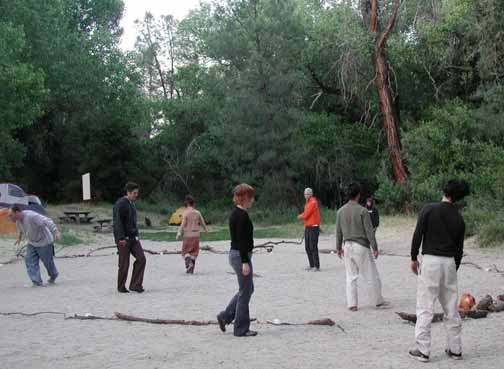
ParaTheatrical ReSearch at Pinnacles Wilderness Park, 2005
When we bring our work out to wilderness spaces, it's usually to a forest and/or on or near a mountain or in a valley. I prefer to work in bio-regions with natural borders and a sense of containment, rather than wide open spaces like the desert or the ocean. This helps minimize the dispersion of the presence and energy we work so hard to generate. It's easy to get swept away by the natural beauty of nature which can be wonderful in its own rite but if our ritual intention requires more focus and containment, it's usually far more challenging to work outdoors than indoors. This is why when we work in the wilderness, we spend about two months beforehand working indoors. That way, we can enter the wilderness more prepared and with more confidence in our stamina and staying power.
MYRDDIN MASERY: If you could chose an archtype to describe your current place in life, what would it be and why did you pick it?
ANTERO ALLI: I wouldn't. As a rule, I don't identify with any archetypes outside of the ritual space. Experience has shown me that such actions lead to an inflated sense of self that only buffers direct experience and the receptivity I require to honestly engage in creative states. In paratheatre, we do interact and merge with archetypal forces but always with the intention of disengaging our egos after each immersion. This is made possible by the crux technique of No-Form, a standing Zazen mediation practice that acts as a kind of ego-corrosive solvent. After each ritual immersion, we always stand in No-Form to release our attachment to whatever forces, god forms and archetypes we were engaged in, identified with and/or serving. This practice assures a more scrupulous approach to engaging archetypal energies and restores that critical sense of normalcy that comes with being nobody but ourselves.
MYRDDIN MASERY: What was your most interesting or powerful encounter with a numen?
ANTERO ALLI: They have all been interesting and powerful in different ways and they have also been too many to mention or remember. Past themes have included Anima/Animus, The Ancestors, Crucifixion, The Chakras, Alchemy, Initiation. The current numen we have encountered for the last two years has been through the Dreambody/Earthbody continuum. This theme reflects the aboriginal idea that the planet Earth is dreaming its inhabitants into existence, that we are all being dreamed by the Earth, and that our dreambody and our waking "earth" body are irrevocably linked. And so in these Dreaming Rituals, the mother archetype of the Dreamtime becomes the backdrop for our numen encounters. These rituals are made up of movements recalled from dreams and then, stitched together into movement cycles, a kind of dream choreography, that arouses the powers of dreaming into waking consciousness.
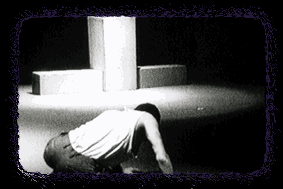
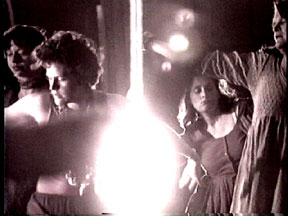
"Crux" (1999) and "Archaic Community" (1991)
MYRDDIN MASERY" The films "Archaic Community", "Crux", and "Orphans of Delirium" were filmed in black and white. How was this decided?
ANTERO ALLI: The were all actually shot in color and in Black & White, though "Orphans of Delirium" is predominantly Black & White with traces of color.
MYRDDIN MASERY: Does the absence of color have significance?
ANTERO ALLI: I convert the image to Black & White whenever I'm looking for a slightly more abstracted quality to the aesthetics of the onscreen action. Black & White brings its own kind of tone and texture removed from the daily life of color vision unless, of course, you normally see in Black & White. I also tend to find ritual movement more arresting in Black & White but maybe that's just a matter of personal taste.
MYRDDIN MASERY: In the production notes of "Orphans of Delirium" you state that, "To me, what matters is the fight itself, the fight for one's consciousness within a maelstrom of chaos; a drama reflecting, for me, the heroic struggle of any person maintaining their individual voice through society's deafening cacophony of conformity." Has a performer ever been so overwhelmed by what they've tapped into that they break down in tears or rage? What were the circumstances and how did you and the participants react?
ANTERO ALLI: Most of us were not raised in families and societies that supported our total commitment to our own direct firsthand experience and the integrity and autonomy resulting from that directive. For many of us, the processes of restoring individual integrity and earning our autonomy must be learned, as if for the first time. Many of us are also entangled in wasteful rebellion against whatever we perceive as the perpetrators of our oppression -- our mothers and fathers, the state, religion, school, etc but it is a waste of time and energy to keep fighting a losing battle. I think once you discover what is worth fighting for there is less compulsion to fight against whatever rubs your ego the wrong way. For me, what is worth fighting for is my consciousness and the freedom to expand my consciousness to perceive more reality if only to determine what I actually care about and what I honestly don't give a dang about. Otherwise, I remain sheep-like and dependent of secondhand information to guide me along; a half-life at best and not for me.
Tears and rage, if honestly felt and expressed, can serve the emotional truth and integrity of the moment. However, when these emotions are repressed or denied, a kind of damage can occur. Constant emotional repression and denial has a way of twisting people into distorted versions of their true selves. I guess that's what they call neurosis.
As for performers becoming overwhelmed, that is a risk every performer worth their salt already knows about and works closely with. In paratheatre training, certain skills can be developed for transforming powerful emotions -- rage, sorrow, ecstasy -- through the muscles and the breathing processes so they don't lead to burnout or unhealthy exhaustion. There are ways to "be on fire" without burning out. There is also a kind of healthy exhaustion that can trigger a second wind and transport the performer to new levels of grace.
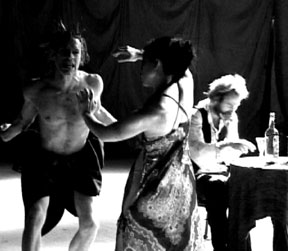
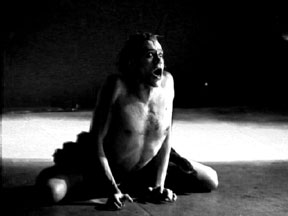
Orphans of Delirium (2004) San Francisco
In the performance of "Orphans of Delirium", the audience did not have the luxury of knowing what was going on in the ritual beyond their own intuitive experience of the actions performed and the forces and presence released onstage. A few audience members walked out when no explanations were offered but most remained glued to their seats, mesmerized by a phenomena they could not understand but the effects of which were undeniable. I create art to move people and to reach them in deep ways. Since I am very impact-oriented as an artist, I don't need the audience to understand everything I create but I would feel like a failure if I failed to reach them viscerally and spiritually. In my feature-length fiction films, I offer more intellectual scaffolding through story, plot and dialogue to get my vision across.
MYRDDIN MASERY: Again thank you for your time. If there are any specific experiences with Paratheatre you'd like to share, please do so.
ANTERO ALLI: Oh, you're welcome. The only thing I'd like to add here is that most of our work is non-performance oriented. There is no audience and the pressure to perform is released and replaced by participants creating their own pressure. This pressure can be created by learning how to increase the force and heat of your own commitment to whatever you are doing, in life and in ritual, so that you can move towards the experience of a total act, of giving yourself over totally to whatever you are doing. This kind of commitment is very rare yet essential for any genuinely transformative work in ritual. Without it, we run the risk of losing power and producing mediocre, half-baked results. Anything that can effectively increase the power of your commitment becomes an important ritual of Self-initiation.
other interviews with antero alli
ParaTheatrical ReSearch site map
